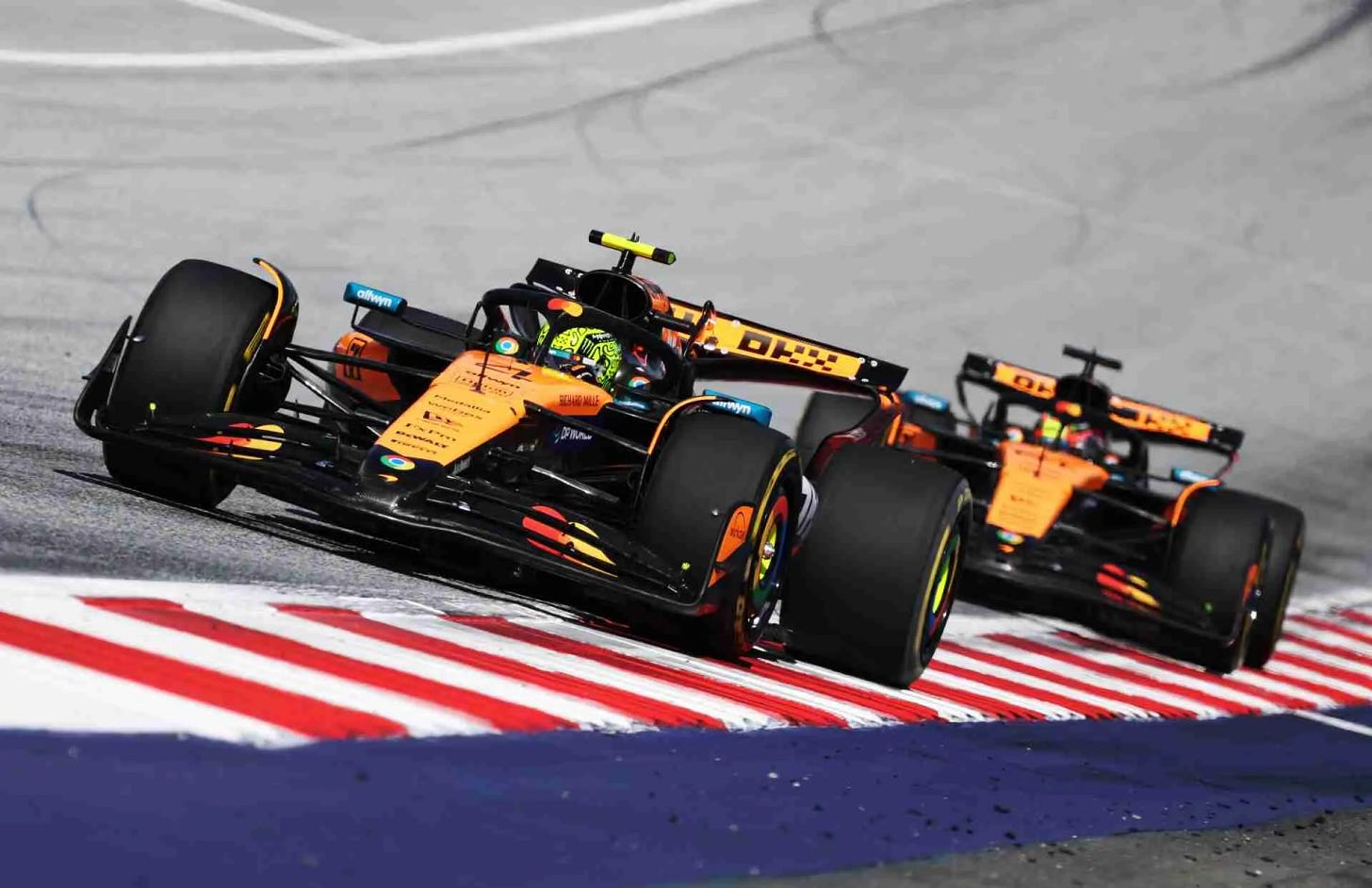Austria. The Red Bull Ring, or the Hungaroring to the purists. Amidst the crowds of the screaming Max Verstappen fans, the “Orange army”, the spotlight was on the cars of the papaya orange variety as Lando Norris bounced back from a disastrous Canadian Grand Prix to take pole by 0.5 seconds—the largest margin of the season. The 2025 Austrian Grand Prix brought us the intra-team McLaren battle we were promised… for the first 20 laps or so.
This keeps happening, no? Drivers battle each other on track in a stunningly intense fashion, only to drop back to go into the all-dreaded tyre management mode. At the Red Bull Ring, while the McLarens frolicked down the road in their own little party-of-two, the Ferraris and the Mercedes of George Russell were quick to create gaps of 5-6 seconds between them to conserve their tires. This has largely been the story of the season, with the Papaya cars being impossibly gentle on their tires compared to the likes of Ferrari, Red Bull and especially Mercedes. Still, they have not been spared from the horrors of dirty air, which was supposed to be solved by the new 2022 regulations for this set of ground effect cars. Too many technical-sounding words in that sentence? Let’s break it down then.
Formula 1 cars need speed. Obviously. Less obviously though, they need downforce. While raw speed and less drag allows cars to reach speeds of more than 350 kph in a straight line, downforce is what keeps these fast cars glued to the track during the corners. But what is downforce? Very simply, it is the downward force generated by air flowing over, under, and through the car. Now, the 2022 regulations saw Formula 1 enter the era of “ground effect cars,” in which the aerodynamics of the car’s floor plays an increasingly important role in generating downforce. The goal of every team to (literally) streamline air flow through the car, maximizing the speed of the air through the floor to create low pressure areas underneath the car, that “suck” the car towards the track, generating downforce. If you’ve ever observed the shape of an F1 car, you’ll notice that the front wing, nose, halo and engine cover connect harmoniously to form a relatively smooth upward curve from the front of the car, all in a bid to allow airflow with minimum obstructions.
Naturally the air flowing through the car, after being moulded to its curves and crevices, it becomes turbulent as it exits the vicinity of the car. This is what is referred to as “dirty air,” and is what becomes detrimental to the aerodynamic performance of the car behind. One of, if not the biggest contributor to this turbulence, is “front wheel wake.”
Imagine watching a river of water running past you. Its flow is smooth, clear, laminar. Now imagine, you place two rocks in the path of the flow. Suddenly, it’s chaos. The water must now split into individual little streams and curve past those rocks, and join back together to form some semblance of a smooth river after passing the rocks. This is what happens to air as it flows through a Formula 1 car. But wait, didn't we just talk about how formula 1 cars are harmoniously built to facilitate air flow rather than hinder it? Well, there’s a reason “dirty air” is widely talked about in Formula 1, and less so in other tour car or GT racing series: Formula 1 is an open-wheel racing series. Think back to the shape of an F1 car; while the front wing, nose and halo form a smooth ride for air flow, its front wheels stick out like… well, like two ungainly rocks in an otherwise smooth river. The effect of these wheels is what is (not) affectionately called “front wheel wake.”
But what does dirty air do? Dirty air clearly messes up the aerodynamic performance of a car, but its effects go deeper than that. Dirty air messes up the performance of the floor in generating downforce, requiring the driver to rely more on mechanical grip from the tires instead. This leads to increased load and energy going through the tires, causing—you guessed it—the all-dreaded overheating and increased tyre degradation.
Now, the 2022 regulations were meant to reduce the effects of front wheel wake but… has it, really? It’s the last year of these regulations before F1 goes through a complete overhaul in 2026. 8 out of the 11 races so far of 2025 have been won by the driver getting pole position, who is generally—big surprise—also the driver enjoying clean air for majority of the race. Still, there are other factors that go into winning a race. What is undisputed though, is that multiple races this season, including the Austrian GP, have seen the effects of front wheel wake and dirty air dictate race and tyre strategies. The 2026 regulations attempt to further control front wheel wake to achieve “optimal wake performance,” but only time will tell the effectiveness of these measures.
Sources
https://www.racecar-engineering.com/tech-explained/slipstream-and-dirty-air-explained/
https://www.formula1.com/en/latest/article/explained-2026-aerodynamic-regulations-fia-x-mode-z-mode-.26c1CtOzCmN3GfLMywrgb2


Brilliant analysis Midhu. I didn't know this much about Dirty Air and its machinations. Also, what is changing in the 2026 regulations that will help reduce the pain of Dirty Air? Whilst DRS et al has helped make the race a little more interesting, I am worried that increasingly F1 races are won or lost much before even the race start. Hope they bring back about a bit more spice in to the business of racing
PS: Hope you watched F1 movie. Its stunning, and please only watch in IMAX. Also in case you are wondering who I am - friend of your dad, from 9th grade onwards
Killer Read!!
Sharp, informative, and laced with just the right amount of personality and technical depth. Nicely done!